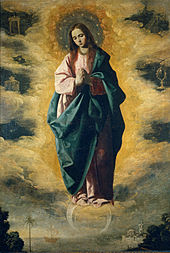Francisco de Zurbarán

Francisco de Zurbarán (baptized November 7, 1598 in Fuente de Cantos in Extremadura , † August 27, 1664 in Madrid ) was a Spanish painter from the Golden Age (" Siglo de Oro ") Iberian baroque art. He mainly painted devotional pictures and saints' lives and, with the ascetic rigor of his pictures, stood entirely on the counter-Reformation line of his mostly church patrons. Since religious occupy a large space in his work, he is sometimes referred to as the "painter of the monks".
Life
Youth and education
Francisco de Zurbarán was born on November 7, 1598 as the youngest son of the merchant Luis de Zurbarán and his wife Isabel Márquez in Fuente de Cantos in Extremadura . There he was baptized on the same day in the Church of Nuestra Señora de la Granada . On November 14, 1599 took place in the same church the confirmation by Francisco de Zurbarán and his siblings María Andrés, Agustín Cristóbal. The Zurbarán family was wealthy: Luis de Zurbarán's business was successful, he owned several houses in the center of Fuente de Cantos and slaves. Part of the family may have traveled from Seville to Peru in the middle of the 16th century, which could explain Francisco de Zurbarán's later contacts with America. The mother Isabel Márquez came from the family of a traveling merchant. Francisco de Zurbarán never used his mother's family name, but signed various documents from 1619 as Francisco de Zurbarán Salazar . This could indicate a Basque or aristocratic origin, since the noble families Zurbarán and Salazar married in Bilbao in the 16th century .
Fracisco de Zurbarán received his first artistic training from a student of Luis de Morales from the Extramadura . Then his father sent him to Seville , the most important artistic center in Spain after Madrid, where he was to be trained as a painter. On January 15, 1614, Zurbarán signed a contract there for a three-year apprenticeship in the workshop of the painter Pedro Díaz de Villanueva. No work has survived by this artist, who was a painter of sacred representations. With his brother, Jerónimo Velázquez , who designed and made altarpieces , Zurbarán probably worked several times during his career. The apprenticeship in Seville was long regarded as unproductive in research, but recent studies show that it was more multifaceted than assumed. Zurbarán met Francisco de Herrera the Elder and Juan de Ruela, important representatives of the naturalistic style in Seville, had contact with his contemporaries Diego Velázquez and Alonso Cano and met the painter and important art theorist Francisco Pacheco . In addition, Zurbarán probably learned sculpture , the colored setting of sculptures and the gilding of retables. Zurbarán completed his training in 1617.
Establishment as an artist in Llerena
Although he had not passed the examination required by the painters' guild of Seville, Zurbarán settled in 1617 as a painter of spiritual motifs in Llerena , an important city in the Extramadura. At the age of 19, he married María Páez Jiménez there that same year, who was nine years older. The Zurbarán biographer María Caturla had classified the social status of the wife's family as low, while recent research shows their prestigious social position in Llerena. María Páez Jiménez also belonged to the family of the Cardinal of Toledo , Juan Martínez Silíceo . This marriage had three children: María, Juan and Isabel Paula. The eldest daughter was confirmed on January 30, 1620, and the son was baptized on July 19 of the same year. Zurbarán's second daughter was baptized on July 13, 1623 in the Church of San Santiago in Llerena. His wife died that year and her funeral took place on September 7th. On April 15, 1624 Júan de Zurbarán was confirmed.
While a lot is known about Zurbarán's family circumstances, there is little information about artistic creation in the early years. In addition to the design for a fountain for the main square in Llerenas, commissioned by the city administration in 1618, only works that are now considered lost are preserved in the documents. In the following year he painted a painting for the portal of the local church of Nuestra Señora de Villagarcia . On August 17, 1622 he received the order for a reredos in the church Nuestra Señora del Rosario in his native town Fuente de Cantos, which should show the 15 mysteries of the rosary . This reredos should include paintings as well as sculptures and gilding. Zurbarán commissioned an artist from Mérida with the sculptural tasks, with whom he shared the sum of 2250 reales. Zurbarán also made structures for a procession during Holy Week for the city of Fuente de Cantos . On August 10, 1624, Zurbarán was commissioned to produce the sculpture of the Crucified for the Nuestra Señora de la Merced monastery in Azuaga , Badajoz .
Although the early work is unknown, it is certain that Zurbarán already had an important workshop at that time and must have enjoyed a high reputation in the region. Three apprentices or assistants can be traced in the sources for the time in Llerena: Manuel Rodríguez was a local painter, while Juan Gerrera, a relative of Zurbarán, and Diego Muñoz Naranjo , who accompanied Zurbarán throughout his career, entered the workshop young entered and should follow the master to Seville in 1626. Zurbarán married the older widow Beatriz de Morales for the second time in 1625. She came from a wealthy family who had relatives in the colonies. In December of that year, Zurbarán settled in his wife's house in Plaza Mayor in Llerena. A quick marriage was required, since the care of the children as well as the assistants and apprentices in the painting workshop were among the tasks of the master's wife. The only daughter that would result from this marriage died in childhood.
First orders in Seville
In 1626, Zurbarán's career shifted to Seville, although he remained a citizen of Llerena. Among other things, this was facilitated by the fact that Lorenzo de Cárdenas , IX. Count of Puebla del Maestre, who came from one of the noblest families Llerenas, the Office of the asistente of Seville, which corresponded approximately to the role of a mayor, held. Zurbarán was in touch with this family throughout his career. On January 17, 1626, Zurbarán signed a contract with Diego de Bordas , the prior of the Dominican monastery of San Pablo el Real in Seville, for 21 paintings: 14 should show scenes from the life of St. Dominic , four the doctors of the church and the last three the saint Bonaventure , Saint Thomas Aquinas and Saint Dominic should show. The artist created this series within eight months for a fee of 4000 reales. It marked Zurbarán's final breakthrough, as the paintings were received extremely positively and as a result almost all of the city's monasteries awarded him orders. In 1627 Zurbarán also painted the Crucified Christ for this monastery , who was hung in the sacristy . It is the artist's first known signed and dated work. On August 29, 1628, on the occasion of the canonization of Petrus Nolascus, the prior of the Nuestra Señora de la Merced Calzada monastery in Seville, Juan de Herrera , commissioned Zurbarán to paint 22 paintings with episodes from the life of the order's founder. The contract ran for a year and included a fee of 16,500 reales. This meant a significant increase over the previous series of pictures and income, such as Francisco de Herrera the Elder received at that time . Since Zurbarán was still based in the Extramadura, where he had an important workshop, he and his assistants settled in the monastery for this assignment. He probably did not complete the series ordered, but compensated for this with a saint Serapion for the Sala de Profundis, where the dead were laid out, and portraits of scholars for the library of the monastery. During this time four paintings were also created for the church of the French monastery of San Buenaventura, one of which is at Herrera d. Ä. in order given Buenaventura should complete cycle. More pictures were planned, the reasons why there were only four in the end are not known.
Seville branch
On August 29, 1629, the Seville City Council asked Zurbarán to move his residence to the city to continue his activities there. He complied and settled with his family and assistants near the cathedral. In the following year, the painters of Seville, led by Alonso Cano , demanded that Zurbarán should take the guild examination that is mandatory for painters in the city. He rejected the request and was able to evade the examination due to his status as a successful artist, who also enjoyed the support of the city council. His first contract as a resident of the city, in which he was also referred to as a "master painter", Zurbarán signed on September 26, 1629, which included the gilding and painting of an altarpiece dedicated to Joseph of Nazareth for the church of the Santísima Trinidad Calzada monastery in Seville . He worked as a subcontractor for the painter Pedro Calderón and probably delegated most of the job to his employees. The following decade was the culmination of Zurbarán’s creative work, both qualitatively and quantitatively. On the one hand, his workshop produced large picture cycles for the domestic and American market, and on the other hand, he also created numerous works by hand.
In 1630, on behalf of the City Council, Zurbarán painted an Immaculate Conception that was hung in the lower hall of the town hall. In the following year he created The Apotheosis of St. Thomas Aquinas , which is the largest painting in Zurbarán's work and was intended for the reredos of the high altar of the church of the Dominican College of Santo Tomás . As part of this commission, he worked with the altar builder Jerónimo Velázquez , the younger brother of his former master. In 1633, Zurbarán produced his only known group of apostles, with varying participation of his workshop, which was found in the monastery of São Vicente de Fora in Lisbon in the 19th century . The circumstances of the order are unknown. Zurbarán created numerous devotional pictures between 1631 and 1634. The first version of the handkerchief of St. Veronica dates from 1631 , a motif that he took up several times in the following years. The same applies to the Agnus Dei , one of his most famous works, which was copied many times both by Zurbarán himself and in his workshop. Zurbarán's first still lifes, such as the still life with lemons, oranges and a rose , also date from this period .
Nationwide successes
Due to his success in Seville and possibly at the suggestion of Gaspar de Guzmán, Conde de Olivares , Zurbarán was invited to the Madrid court in 1634. There he received the order for a series of pictures for the Hall of the Kingdoms (Salón de Reinos) in the Palacio Buen Retiro , which - apart from one loss - is now in the collection of the Museo del Prado . This series includes ten paintings showing the heroic deeds of Heracles . These are the only known paintings with mythological motifs in Zurbarán's work. The royal commission was rewarded with 1,100 ducats. After completing work on these paintings, Zurbarán quickly returned to Seville. Nevertheless, his stay at the court of Philip IV had an impact on Zurbarán's work, as he was able to study the king's Italian collection as well as with important painters of his era such as Diego Velázquez , Vicente Carducho , Juan Bautista del Maíno , Angelo Nardi , Eugenio Cajés and Antonio de Pereda came into contact. These influences resulted in a significantly lighter palette for the artist after his return, even if he largely retained his design.
The first trade contacts with the New World can also be traced back to this time around the mid-1630s, and thus earlier than research had long suspected. There are litigation files from 1640 in which Zurbarán sued the captain Diego de Mirafuentes for damages because paintings intended for sale in Lima were damaged on the crossing in 1636 and thus became unsaleable. Early trading contacts with the colonies also appear not unlikely due to the family connections of both Zurbaráns and his first two wives. The trial files also give an insight into the workshop of the master, as the assistants Ignacio de Ries , José Durán , Diego Muñoz Naranjo and Alonso de Flores were listed as witnesses. Because of the losses from this company, Zurbarán had difficulties in 1638 to pay the high dowry of 2000 ducats at the wedding of his eldest daughter María.
On August 19, 1636 Zurbarán received the order for a new altarpiece for the Church of Nuestra Señora de la Granada in Llerena, which he created in collaboration with Jerónimo Velázquez, where he took over the painting. Although this altarpiece was removed in the 17th century, two paintings of this commission have been preserved in the church. Another commission for the artistic design of a high altar was given to Zurbarán on May 26, 1637 for the church of the La Encarnación monastery in Arcos de la Frontera . The six paintings in this retable are lost.
In contrast, almost all of the paintings in his two most important series have been preserved: In 1638 and 1639 Zurbarán created a series of paintings for the Carthusian Monastery of Nuestra Señora de la Defensión in Jerez de la Frontera . The paintings in this series, executed and dated by the artist himself, have been preserved, but are in various museums. On March 2, 1639, Zurbarán signed a contract with Father Felipe de Alcalá , which included seven paintings for the sacristy of the Guadelupe Monastery in Cáceres . This series of paintings is the only Zurbaráns that is still at its destination. The painting The Mass of Father Cabañuelas , dated 1638, was probably delivered in advance as a work sample , which was supposed to prove Zurbarán's ability to work on a cycle without iconographic models, based solely on specifications from the monastery. August 15, 1639 was agreed as the delivery date for the remaining six paintings. Since these are large-format paintings, which were also created at the same time as the commission for Jerez de la Frontera, one must assume that the assistants of the workshop were involved, even if the works have so far only been attributed to Zurbarán. On March 28, 1639, Zurbarán's second wife was buried in the La Magdalena church in Seville. Assumptions that the artist wanted to enter a monastery as a result of this loss are unfounded. During this time Zurbarán maintained his contacts with the court. So he sent his best gilders to Madrid and also helped to furnish the ship Rey San Fernado , which Philip IV received as a gift from the city of Seville.
Seville plant
The narrative cycles of the 1630s were followed from 1640 onwards by picture sequences of the founders of the order , the apostles and female saints. Between 1640 and 1650, the production of Zurbarán and his workshop multiplied. This was due to the many orders, including for the American market. Between 1640 and 1645 Zurbarán produced the series of legendary fighters, the Infants of Lara, for the colonies , but also cycles of the biblical patriarchs and Roman Caesars, for which he used engravings of various European origins as models. He also worked on subjects such as the Immaculate Conception , the childlike Christ, the handkerchief of Veronica and depictions of St. Francis . Zurbarán also occasionally produced still lifes that are considered masterpieces. It can be stated, however, that it stagnated at a high level. Hardly dated or documented works have survived for the years 1640 to 1655.
On February 7, 1644, Zurbarán married the wealthy young widow Leonor de Tordera. She came from a family of goldsmiths and silversmiths. Her brothers provided her with a dowry of 27,700 reales, the same as that of her father when she first married Diego de Sotomayor, who had perished in Puebla, Mexico . With this he had six children who were baptized between 1645 and 1655 in the parish church of Sagrario . Apart from María, who was born in 1650, they may have died as young children. In 1645 Zurbarán and his wife moved into a rented house near Seville Cathedral, which was one of the old palace buildings of the Alcázar of Seville.
On May 22, 1647 he concluded a contract with the captain Juan de Valverde, which included ten scenes from the life of the Virgin Mary and 24 paintings of virgins . These pictures, which were sent to the La Encarnación monastery in Lima , were rewarded with 2000 pesos, 16,000 reales. All paintings are now lost. Aside from selling paintings from his workshop, Zurbarán also traded in Flemish landscapes and painting materials, as evidenced by a delivery to Buenos Aires in 1649. In addition to trading with the New World, Zurbarán had good relationships with the local aristocracy and also with representatives of the high nobility, for whom he repeatedly carried out orders. However, Zurbarán's life in Seville became more difficult due to political and economic changes. In addition, Zurbarán's son Juan , who had assisted his father in the studio, died on June 8, 1649 during the great plague epidemic in Seville. On April 9, 1650, Zurbaran's daughter María Manuela was baptized. It may have served as a model for some of the paintings showing Mary with the Christ Child. Around 1650 Zurbarán was working on the reredos for the San Pedro chapel in Seville Cathedral . The paintings on this order have been preserved at the original installation site. Around 1655 Zurbarán painted three large paintings that were intended for the sacristy of the Carthusian monastery of Santa Maria de las Cuevas in Seville and are now in the collection of the Museo de Bellas Artes in Seville. Overall, only a few signed works from this difficult period are known. According to the church book of Seville Cathedral, the Zurbarán family lived on Calle Abades from 1656 to 1658. The worsened economic situation was probably also the reason for the move to Madrid.
Late work in Madrid
In May 1658 Zurbarán moved to the court in Madrid, where he mainly painted devotional pictures for noble clients. This move was probably connected with the hope of being appointed Pintor de Cámara , court painter. Various small-format, dated and signed paintings have come down to us from this year, which perhaps should serve as a recommendation to the new private clientele. As part of Diego Velázquez 's entrance exam for the Santiagoorden , Zurbarán and Bartolomé Esteban Murillo , Alonso Cano and Juan Carreño de Miranda gave testimony in his favor on December 23, 1658. In Madrid, Zurbarán continued to develop artistically at the end of his life. Although he did not follow the baroque style of the court influenced by Francisco de Herrera the Elder , Juan Carreño de Miranda and Francisco Rizi , he did take on influences from Venlázquez and from Italian painting. He found a market for work in this style in Madrid. According to Palomino , Zurbarán also worked again for the king. In 1660 he completed a decoration that Alonso Cano had begun for the chapel of the Franciscan monastery of Santa María de Jesús in Alcalá de Henares , for which he created two large-format paintings. Zurbarán painted his last signed picture in 1662 with the Virgin Mary with the Baby Jesus and St. John . During this time he had increasing financial problems, which resulted from the fact that he could not collect outstanding debts from his orders and exports. He owed the Hieronymites rent of 8,000 reales over three years. He was able to pay 2,000 reals and offered the monks to create 20 paintings according to their specifications if he could not pay the outstanding sum by the end of 1659. In addition, his health deteriorated increasingly. On August 26, 1664, the day before his death, the painter wrote his will, in which he recorded his wish to be buried in the Convent de los Agustinos Recoletos Descalzos in Madrid. Zurbarán died in Madrid on August 27, 1664. His wife Leonor de Tordera pledged the family's silver to finance the costs of illness and burial. The will gives information about the artist's financial situation: he had no debts and possessed possessions that were no different from those of his peers. Daughters from their first marriage, María and Isabel Paula, were appointed as heirs.
Picture themes
The painter's fame began with series of paintings in which visions and legends of religious were spread. His full-length figures of saints and religious, placed in a steep upright format, are also repeated in cyclical contexts. Occasionally he also paints direct portraits from life. Representations of St. Francis. mostly kneeling down in meditative contemplation of a skull, he painted in over 50 versions since the 1630s. The male portraits are characterized by the monumental effect of the voluminous billowing robes, the female saints are often wrapped in precious fabrics, which are reproduced with attention to detail. The portraits and figures of saints manage without any allegorical accessories.
The need of Spanish churches for Marian themes was unlimited in the age of the Counter Reformation . Above all, the representation of the Immaculata recurs in all periods of his work. The painter had owed the issue here by the otherwise dark preferred fund to deviate and set the floating Our Lady in front of pink to golden glowing, populated by shadowy angels sky backgrounds.
Important clients were the monasteries of the Carthusian Order . He supplied the Madonna in the protective cloak and two other large paintings for the Charterhouse of Santa María de las Cuevas , the altarpiece (1633) and a cycle of paintings for the Charterhouse of Jerez (today in Cadiz and Grenoble).
Profane subjects such as battle scenes and mythological subjects, which he painted for the king in 1634, remain an exception in his oeuvre.
Still life plays a special role in Zurbarán's oeuvre . Only a few autonomous “bodegones” come from his own hand. (In his large workshop his son Juan (1620–1649), who died early, had dedicated himself to this genre). However, in various large interiors, details that are arranged in the manner of still life and painted in an almost hyper-realistic way are striking. The same impression of materiality seen closely are made by the paintings of the handkerchief of St. Veronica and the very realistically tied creature given to the slaughter of God . Both series of motifs show the painter's ability to make concentrated statements and to use his painterly means in a targeted manner.
The almost pre-baroque, mannerism-like, almost "Gothic" way of composing was attempted to explain the almost pre-baroque, mannerism-like, almost "Gothic" way of composing from the use of prints from Italy and the Netherlands from the 16th and 17th centuries (his estate contained a large collection of such engravings).
In the last years of his life, when the large commissions faded, the design of his devotional pictures became more narrative, scenes from the apocrypha and details from everyday life were added and thus met the bourgeois picture taste ( Jesus child with a crown of thorns, The sleeping Maria as a young girl, The Departure of the Holy Family from Egypt ).
Style development
His early works show their own "strong, naturalistic" style, which is based on strong light and dark effects ( tenebrism ). In this he was related to Caravaggio and Ribera . With sharp contours and hard shadows, he achieved strong plastic effects that make his robed figures look like monumental sculptures. Around the middle of the 1630s, he softened the extreme contrasts and also allowed more uniform lighting and brighter colors. His figures, however, remain - with all the painterly delicacy, all the realism and elegance of the reproduced textiles - rather clumsy statuary. The figures stand tall and motionless in the frame. As tangibly plastic as the voluminous robe figures are modeled - they show a three-dimensionality that finds no equivalent in the spatial staging, for example through staggered depths or dramatic movement. This is where Zurbarán differs from most of his Dutch and Italian contemporaries.
His and his son's sober still lifes, arrangements of fruits and sparse flowers that appear almost unreal in cold light, are strikingly sparse and ascetic in comparison to the lavish ensembles of the Dutch contemporaries. Landscapes rarely play a role in his pictures. With the exception of his late work, dramatically enriched representations are almost entirely limited to large-format commissioned works such as the battle pictures and the Hercules cycle, which he created for the Buen Retiro Philip IV palace in Madrid. During this time, his palette brightened, perhaps under the impression of Italian pictures that he got to know in King Philip's picture gallery. The preference of the art public also turned away from the serious conception and realistic painting style since the middle of the century. The future belonged to genre-like scenes in softer, “painterly” contours and lively colors.
Zurbarán lacked the drama of Caravaggio (who nevertheless had a strong influence on him, albeit indirectly) or the courtly elegance of Velázquez, who was of the same age, to compare him with other main figures of southern European baroque painting . He was also far from the popular courtesy and sentimentality that Murillo, 20 years his junior , cultivated in Seville.
aftermath
Zurbarán was not followed by a notable school . Only the pioneers of modernity rediscovered it. Eugène Delacroix's diary notes show the great impression that the paintings kidnapped by Napoleon from Spain made on the pioneers of Impressionism. In 1838 a gallery Espagnole was set up in the Louvre . Of the 450 paintings, 80 were by Zurbarán. Gustave Courbet , Paul Cézanne and Salvador Dalí referred to him, Paula Modersohn-Becker drew in front of his pictures in the Louvre, and the Fluxus artist Wolf Vostell , who built his Museo Vostell Malpartida near the birthplace of Zurbarán in Extremadura, was from deeply impressed the Spaniard.
Works (selection)
Unless otherwise stated, these are paintings on canvas. The table can be sorted by columns (click on the header).
| image | title | year | Dimensions | collection | link |
|---|---|---|---|---|---|

|
Saint Casilda | 1630-1635 | 171 × 107 cm | Madrid, Thyssen-Bornemisza Museum | |

|
The death of Hercules . From a cycle of paintings for Buen Retiro Castle (two battle pictures and ten Hercules scenes) | 1634 | 136 × 167 cm | Madrid, Prado Museum | |

|
Saint Luke, depicted as the painter of the crucifixion scene | 1660 approx. | 105 × 84 cm | Madrid, Prado Museum | |

|
Still life | 1650 approx. | 46 × 84 cm | Madrid, Prado Museum | Still life |
| St. Elisabeth of Hungary (formerly "Saint Casilda") | 1635-1642 | 184 × 90 cm | Madrid, Prado Museum | Saint Casilda of Burgos | |

|
The vision of the apostle Peter St. Petrus Nolascus | 1629 | 179 × 223 cm | Madrid, Prado Museum | The vision of the apostle Peter St. Petrus Nolascus |

|
Defense of Cadiz against England | 1634 | 302 × 323 cm | Madrid, Prado Museum | wga.hu |
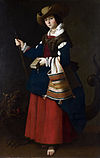
|
Saint Margaret | 1631 | 194 × 112 cm | London, National Gallery | Saint Margaret |

|
St. Andreas | 1631 | 146.7 × 61 cm | Budapest, Szépművészeti Múzeum | St. Andreas |

|
Saint Apollonia | 1636 | 113 × 66 cm; | Paris, Louvre | Saint Apollonia |

|
Saint Bonaventure on his death bed | 1629 | 250 × 225 cm; | Paris, Louvre | Saint Bonaventure on his death bed |

|
The Adoration of the Shepherds | 1638-1639 | 261 × 175 cm | Grenoble, Musee de Grenoble | Adoration of the Shepherds |

|
Still life with lemons, oranges and roses | 1633 | 60 × 107 cm | Pasadena, Norton Simon Museum | Still life |
| Vision of Saint Alphonsus Rodriguez | Madrid, Real Academia de Bellas Artes de San Fernando | Vision of Saint Alphonsus Rodriguez | |||

|
Saint Agatha | 1630-1633 | 127 × 60 cm | Montpellier, Fabre Museum | Agatha |
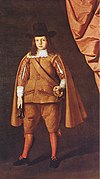
|
Portrait of the Duke of Medinaceli | 1650 approx. | 110 × 178 cm | Toledo, Museo Hospital de Tavera | Medinaceli |
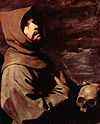
|
St. Francis | 1660 approx. | 64 × 53 cm | Munich, Alte Pinakothek | St. Francis |

|
St. Hugo in the Carthusian refectory | 1633 approx. | 102 × 168 cm | Seville, Museo de Bellas Artes | St. Hugo |
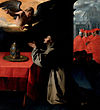
|
St. Bonaventure in prayer | 1629 approx. | 239 × 222 cm; | Dresden, Dresden State Art Collections , Old Masters Picture Gallery | |
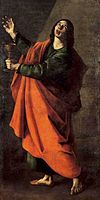
|
St. John Evangelista | 1633 | 218 x 111.5 cm | Lisbon, Museu Nacional de Arte Antiga |
literature
- Beat Wismer, Odile Delenda and Mar Borobia: Zurbarán. Catalog for the exhibition Museum Kunstpalast Düsseldorf, Hirmer, Munich 2015.
- Cees Nooteboom : Zurbarán - Selected Paintings 1625–1664. Munich 2010.
- Paul Guinard: Zurbarán et les peintres espagnols de la vie monastique. 2nd Edition. Paris 1988.
- Mina Gregori, Tiziana Frati: L'opera completa di Zurbarán. Milan 1973.
- J. Vaquero: Zurbarán. In: Germain Bazin: Kindler's Painting Lexicon. Volume 5, 1968, pp. 349-356.
- James Hogg: Francisco de Zurbarán. In: Biographisch-Bibliographisches Kirchenlexikon (BBKL). Volume 14, Bautz, Herzberg 1998, ISBN 3-88309-073-5 , Sp. 628-652.
- Francisco de Zurbarán . In: Hans Vollmer (Hrsg.): General lexicon of fine artists from antiquity to the present . Founded by Ulrich Thieme and Felix Becker . tape 36 : Wilhelmy-Zyzywi . EA Seemann, Leipzig 1947, p. 600-603 .
- Bénézit. Volume XIV, pp. 944-946 ( online in the Grove Dictionary of Art . Subscription Access).
Individual evidence
- ↑ María Eugenia Alonso: Chronology. In: Beat Wismer, Odile Delenda, Mar Borobia (eds.): Zurbarán. Hirmer, Munich 2015, ISBN 978-3-7774-2418-7 , pp. 267-272, 267.
- ↑ Odile Delenda: Francisco de Zurbarán: Life and Work. In: Beat Wismer, Odile Delenda and Mar Borobia (eds.), Zurbarán. Hirmer, Munich 2015, pp. 17–34, 17.
- ↑ Odile Delenda, Francisco de Zurbarán: Life and Work. In: Beat Wismer, Odile Delenda and Mar Borobia (eds.), Zurbarán. Hirmer, Munich 2015, pp. 17–34, 17 and 18.
- ↑ a b c Odile Delenda, Francisco de Zurbarán: Life and Work. In: Beat Wismer, Odile Delenda and Mar Borobia (eds.), Zurbarán. Hirmer, Munich 2015, pp. 17–34, 18.
- ^ A b María Eugenia Alonso, Chronology. In: Beat Wismer, Odile Delenda and Mar Borobia (eds.), Zurbarán. Hirmer, Munich 2015, pp. 267–272, 268.
- ↑ a b c María Eugenia Alonso, Chronology. In: Beat Wismer, Odile Delenda and Mar Borobia (eds.), Zurbarán. Hirmer, Munich 2015, pp. 267–272, 269.
- ↑ a b c d Odile Delenda, Francisco de Zurbarán: Life and Work. In: Beat Wismer, Odile Delenda and Mar Borobia (eds.), Zurbarán. Hirmer, Munich 2015, pp. 17–34, 19.
- ↑ a b Odile Delenda, Francisco de Zurbarán: Life and Work. In: Beat Wismer, Odile Delenda and Mar Borobia (eds.), Zurbarán. Hirmer, Munich 2015, pp. 17–34, 20.
- ↑ Odile Delenda, Francisco de Zurbarán: Life and Work. In: Beat Wismer, Odile Delenda and Mar Borobia (eds.), Zurbarán. Hirmer, Munich 2015, pp. 17–34, 20 and 21.
- ↑ Odile Delenda, Francisco de Zurbarán: Life and Work. In: Beat Wismer, Odile Delenda and Mar Borobia (eds.), Zurbarán. Hirmer, Munich 2015, pp. 17–34, 21 and 22.
- ↑ Odile Delenda, Francisco de Zurbarán: Life and Work. In: Beat Wismer, Odile Delenda and Mar Borobia (eds.), Zurbarán. Hirmer, Munich 2015, pp. 17–34, 22.
- ↑ a b Odile Delenda, Francisco de Zurbarán: Life and Work. In: Beat Wismer, Odile Delenda and Mar Borobia (eds.), Zurbarán. Hirmer, Munich 2015, pp. 17–34, 23.
- ^ María Eugenia Alonso, Chronology. In: Beat Wismer, Odile Delenda and Mar Borobia (eds.), Zurbarán. Hirmer, Munich 2015, pp. 267–272, 270.
- ^ María Eugenia Alonso, Chronology. In: Beat Wismer, Odile Delenda and Mar Borobia (eds.), Zurbarán. Catalog, Hirmer, Munich 2015, pp. 267–272, 270 and 271.
- ↑ Odile Delenda, Francisco de Zurbarán: Life and Work. In: Beat Wismer, Odile Delenda and Mar Borobia (eds.), Zurbarán. Hirmer, Munich 2015, pp. 17–34, 24/25.
- ↑ a b Odile Delenda, Francisco de Zurbarán: Life and Work. In: Beat Wismer, Odile Delenda and Mar Borobia (eds.), Zurbarán. Hirmer, Munich 2015, pp. 17–34, 26.
- ↑ Odile Delenda, Francisco de Zurbarán: Life and Work. In: Beat Wismer, Odile Delenda and Mar Borobia (eds.), Zurbarán. Hirmer, Munich 2015, pp. 17–34, 27.
- ↑ a b c Odile Delenda, Francisco de Zurbarán: Life and Work. In: Beat Wismer, Odile Delenda and Mar Borobia (eds.), Zurbarán. Hirmer, Munich 2015, pp. 17–34, 28.
- ^ María Eugenia Alonso, Chronology. In: Beat Wismer, Odile Delenda and Mar Borobia (eds.), Zurbarán. Hirmer, Munich 2015, pp. 267–272, 270 and 271.
- ↑ Odile Delenda, Francisco de Zurbarán: Life and Work. In: Beat Wismer, Odile Delenda and Mar Borobia (eds.), Zurbarán. Hirmer, Munich 2015, pp. 17–34, 29 and 30.
- ↑ a b c Odile Delenda, Francisco de Zurbarán: Life and Work. In: Beat Wismer, Odile Delenda and Mar Borobia (eds.), Zurbarán. Hirmer, Munich 2015, pp. 17–34, 30.
- ^ María Eugenia Alonso, Chronology. In: Beat Wismer, Odile Delenda and Mar Borobia (eds.), Zurbarán. Hirmer, Munich 2015, pp. 267–272, 271.
- ^ A b María Eugenia Alonso, Chronology. In: Beat Wismer, Odile Delenda and Mar Borobia (eds.), Zurbarán. Hirmer, Munich 2015, pp. 267–272, 272.
- ↑ a b Odile Delenda, Francisco de Zurbarán: Life and Work. In: Beat Wismer, Odile Delenda and Mar Borobia (eds.), Zurbarán. Hirmer, Munich 2015, pp. 17–34, 31.
- ↑ Odile Delenda, Francisco de Zurbarán: Life and Work. In: Beat Wismer, Odile Delenda and Mar Borobia (eds.), Zurbarán. Hirmer, Munich 2015, pp. 17–34, 31 and 32.
- ↑ a b c Odile Delenda, Francisco de Zurbarán: Life and Work. In: Beat Wismer, Odile Delenda and Mar Borobia (eds.), Zurbarán. Hirmer, Munich 2015, pp. 17–34, 32.
- ↑ Erich Steingräber: Exhibition review Zurbarán. IV centenario (Sevilla, 1998), in: Kunstchronik 52, 1999, pp. 459–467.
- ↑ The section on style follows the article Zurbaran in: Lexikon der Kunst, Vol. 5, Leipzig 1978, p. 741
- ↑ Erich Steingräber: Exhibition review Zurbarán. IV centenario (Sevilla, 1998), In: Kunstchronik 52, 1999, p. 466.
Web links
- Works by Francisco de Zurbarán at Zeno.org .
- Zurbarán - master of details . Exhibition Museum Kunstpalast, November 10, 2015 to January 11, 2016
| personal data | |
|---|---|
| SURNAME | Zurbarán, Francisco de |
| BRIEF DESCRIPTION | Spanish painter |
| DATE OF BIRTH | November 7, 1598 |
| PLACE OF BIRTH | Fuente de Cantos Extremadura |
| DATE OF DEATH | August 27, 1664 |
| Place of death | Madrid |

